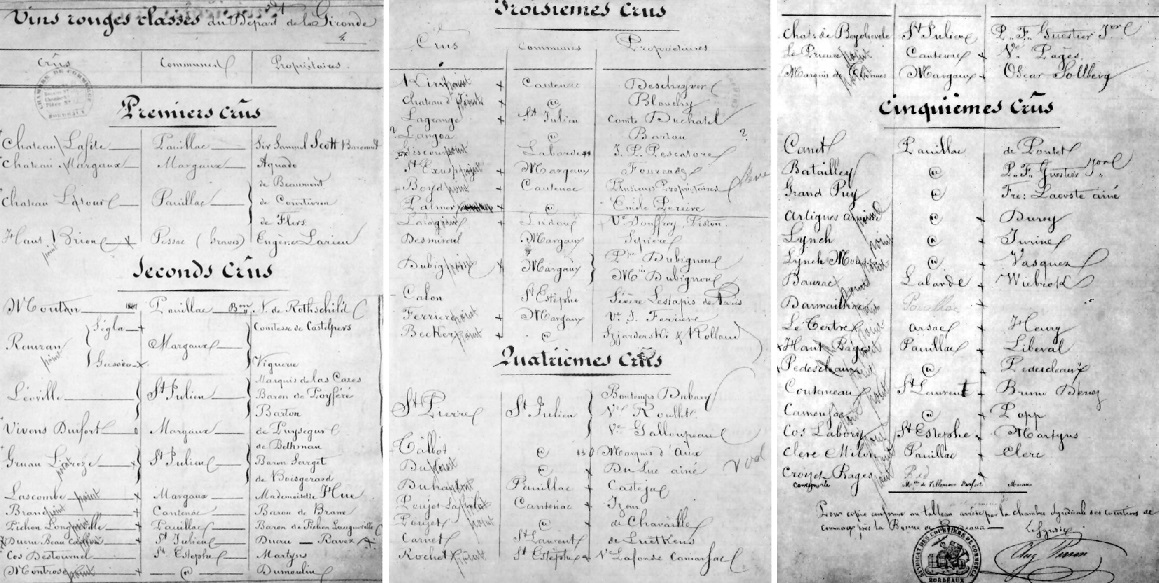Médoc
The wine-growing area belongs to the French region of Bordeaux; the name means "middle land". It is located north-west of the city of Bordeaux on the triangular peninsula between the Gironde estuary, formed by the confluence of the Garonne and Dordogne rivers, and the Atlantic Ocean. Around 70 kilometres long and 5 to 12 kilometres wide, the strip of land dominated by vineyards is interrupted by pastureland, scrubland and polders (floodplain). The area is divided into two regional appellations (Bas-Médoc and Haut-Médoc) and six communal appellations within Haut-Medoc with around 16,000 hectares of vineyards. Médoc is probably the most famous appellation in the Bordelais and also one of the most important and best red wine regions in France and the world.

History
Viticulture came to this region relatively late. In the 17th century, under the guidance of Dutch dam and hydraulic engineering specialists, the coasts were straightened, swampy areas drained and streams regulated. This is why the area was called "La Petite Hollande" for a long time. As there was no viticulture in the area at that time, the Dutch bought wines from the "Bordeaux hinterland", which was known as the Haut-Pays and the wines from there as "Vin de Haut" or "Hooglansche Wijn" in Dutch. Later, many vineyards were planted or small areas were acquired and combined into larger estates, including by the famous Ségur family. Médoc has particularly good conditions for viticulture. These are the mild climate, the very poor and deep gravel soil in many places, which forces the vines to drive their roots deep into the ground, and the good drainage in the soil. Despite the close proximity to the Atlantic, the climate is not humid, as the many pine forests provide excellent protection against winds and rain from the west.
Appellations
Médoc is divided into the northern area Bas-Médoc (usually referred to somewhat confusingly as Médoc, as this does not refer to the entire area) with 5,600 hectares and the southern area Haut-Médoc with 4,600 hectares of vineyards (the sizes refer to the two appellations without the six communes listed below). The border runs from Saint-Seurin-de-Cadourne to the north of the commune of Saint-Estèphe. Haut-Médoc begins at the southern corner of the commune of Blanquefort, which forms the northern border with the Graves area. Both areas are also entitled to their own appellation. They are characterised by very different soil types. In Haut-Médoc, the wines are categorised somewhat higher due to the gravelly soil and have more race and finesse. The six famous communes of Margaux, Moulis, Listrac-Médoc, Pauillac, Saint-Estèphe and Saint-Julien form their own appellations within Haut-Médoc.
The wines from the other communes are labelled "Haut-Médoc", the wines from Bas-Médoc simply "Médoc" or rarely "Bas-Médoc". They are made from the typical Bordeaux blend grape varieties, with Cabernet Sauvignon tending to dominate in Haut-Médoc and Merlot in Bas-Médoc. However, the mix of grape varieties differs mainly depending on whether you are on the Rive droite (right bank) or Rive gauche (left bank) of the Garonne/Dordogne or Gironde. The less important white wines are mainly made from Sauvignon Blanc. Typical of the Médoc are the numerous magnificent châteaux, which also deserve this designation (as "château") from an architectural point of view. However, this is not a sign of quality, as there are also wine estates with very simple buildings where great wines are produced.
Bordeaux classification
The famous Bordeaux Class ification took place in 1855 (the reason for this and the exact procedure is described under this keyword). Out of a total of 4,000 châteaux or red wines, only 61 (the number from today's perspective) were deemed worthy of inclusion in the list. With the sole exception of Château Haut-Brion from the Graves region, only châteaux from the Médoc are included. The official presentation took place with great pomp in the presence of Emperor Napoleon III (1808-1873) on 18 April 1855 and the châteaux were grouped into five classes. Within these five classes, the wines were ranked in descending order based on the average price achieved. Château Lafite-Rothschild was at the top of the list. A facsimile of the handwritten original documents:

Ranking of the châteaux
The ranking of the châteaux at the time is shown below. In a letter from the jury to the Chamber of Commerce dated 16 September 1855, it was noted that there was no qualitative ranking or rating within a level; wines of the same level were to be considered equal. But just one month earlier, the opposite was claimed. Another argument against "equality" is that in the original list the wines were not organised alphabetically or by municipality. The simple reason was probably to avoid upsetting anyone and prevent endless disputes and protests.
Today, the class is rarely mentioned on the label, but often only "Grand Cru Classé en 1855". However, the lesser-known Deuxièmes often refer to their status in order to gain a reputation. Baron Philippe de Rothschild also took the opportunity in 1973 to document the elevation of Château Mouton-Rothschild...
Voices of our members

As honorary chairman of the Domäne Wachau, it is the easiest and quickest way for me to access the wein.plus encyclopaedia when I have questions. The certainty of receiving well-founded and up-to-date information here makes it an indispensable guide.
Hans-Georg Schwarz
Ehrenobmann der Domäne Wachau (Wachau)